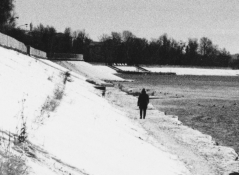I attached 2 crops, one is a negative scan and another one is a wet print.
The film is Foma 400@800 developed in D76 stock.
1) The scan was made with a DSLR and a good macro lens.
2) The wet print was made on 8.5x11 inch RC paper, developed in Dektol 1+2 (Durst - condenser head + Schneider Componon-S 2.8/50mm lens) and then scanned. Not the best scanner, but definitely gives the idea, in reality it looks almost the same.
The negative scan has just a bit more contrast, but a lot more sharpness/acutance and more pronounced grain.
I know that paper's grain is much thinner and it also depends on the size of the print. But is there any way of getting similar high acutance, crispy, grainy image when wet printing?
PS. Probably it's better to move the thread to "B&W: film, paper, chemistry" section.
The film is Foma 400@800 developed in D76 stock.
1) The scan was made with a DSLR and a good macro lens.
2) The wet print was made on 8.5x11 inch RC paper, developed in Dektol 1+2 (Durst - condenser head + Schneider Componon-S 2.8/50mm lens) and then scanned. Not the best scanner, but definitely gives the idea, in reality it looks almost the same.
The negative scan has just a bit more contrast, but a lot more sharpness/acutance and more pronounced grain.
I know that paper's grain is much thinner and it also depends on the size of the print. But is there any way of getting similar high acutance, crispy, grainy image when wet printing?
PS. Probably it's better to move the thread to "B&W: film, paper, chemistry" section.
Attachments
Last edited:














